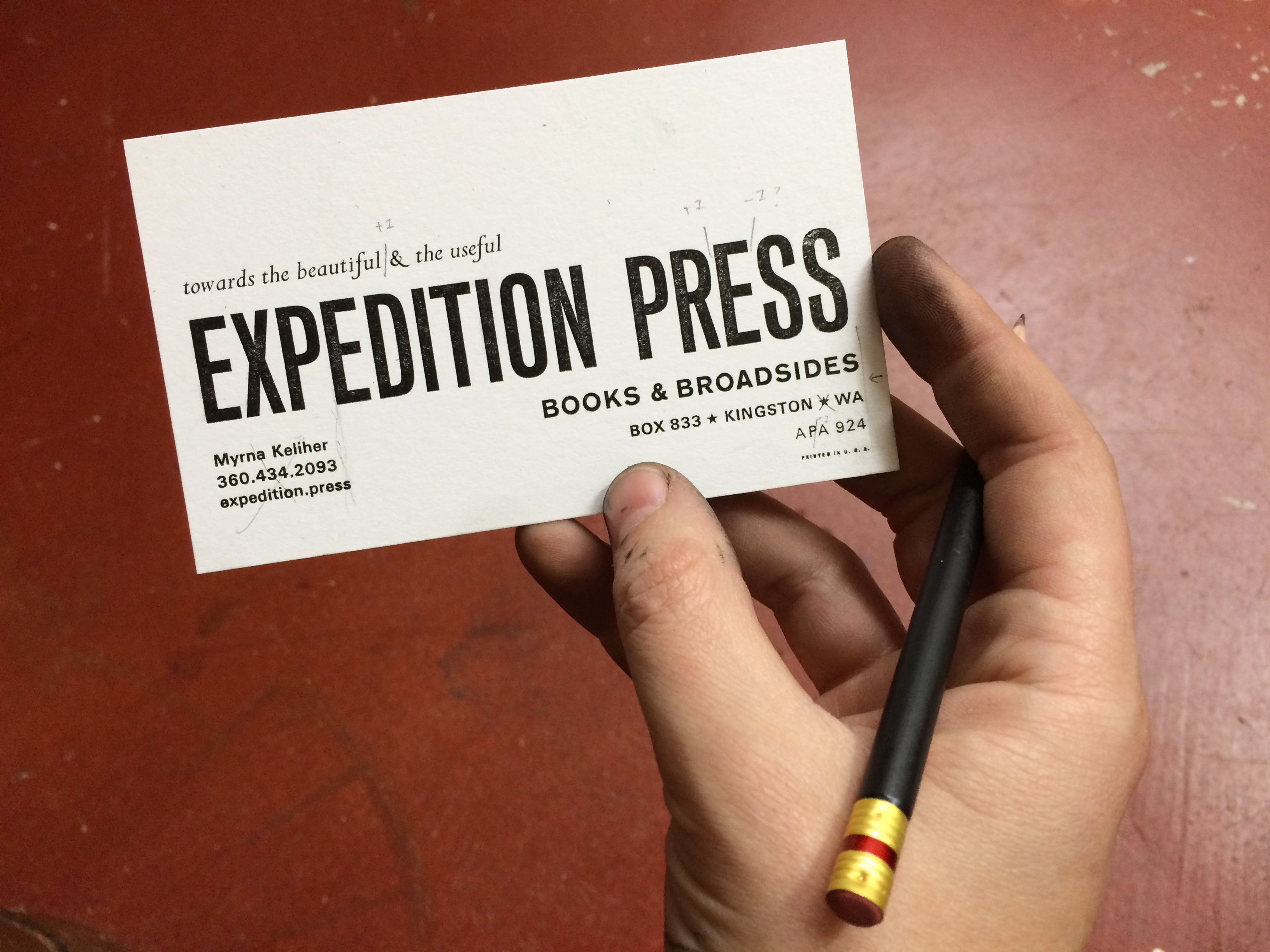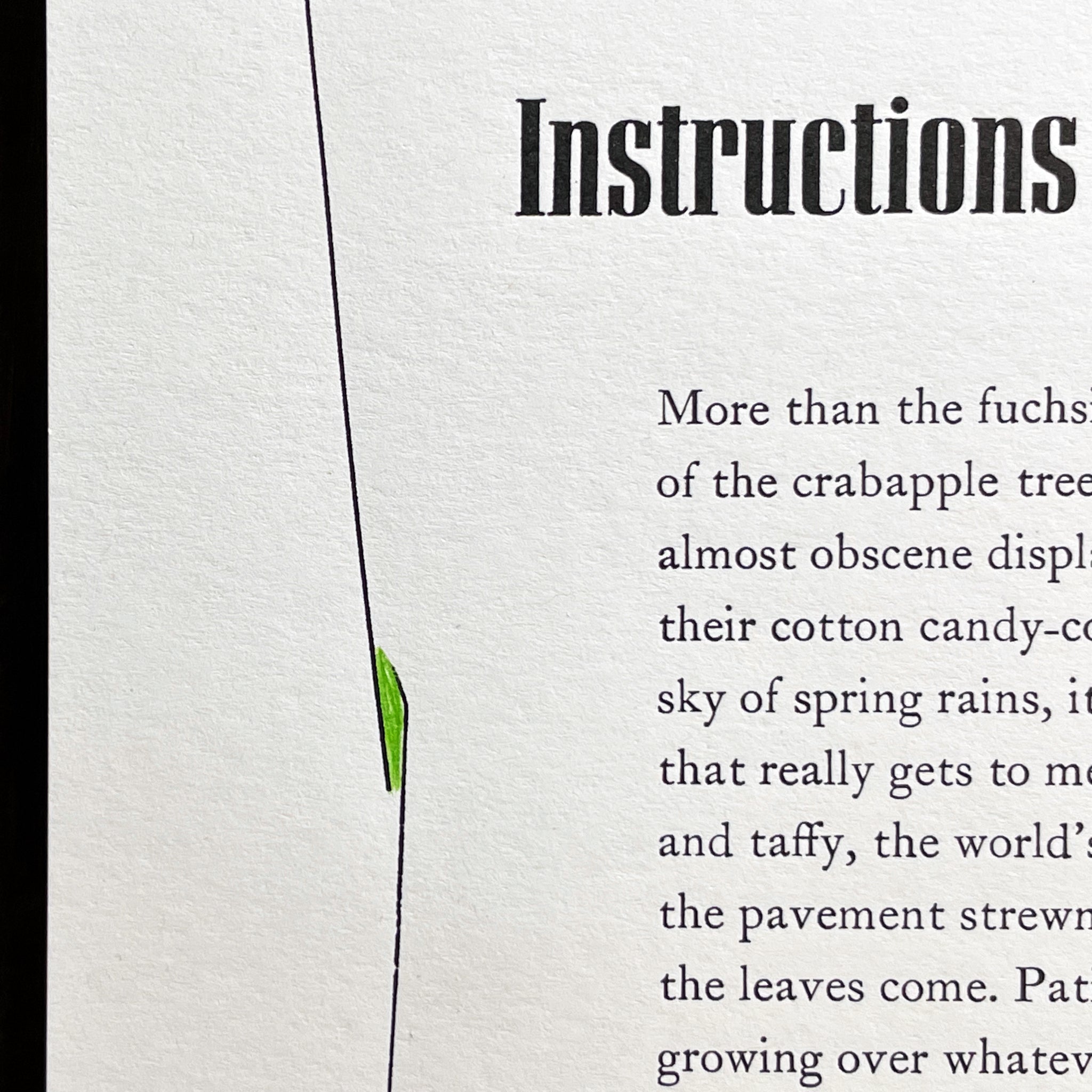Broken Broadsides

Detail of metal type form from Broken Broadside 1. Words by Cedar Sigo. See the whole Broken Broadside series here.
Lately I’ve been thinking a lot about my voice as an artist and my role as a publisher: how they inform and whether they inhibit each other. I feel a strong insistence (born of insecurity?) that I should divide these actions and define them. You know, really nail down what it is I’m doing. Then I forget. I keep making things the way it naturally occurs to me, and I watch how these activities of artist and publisher weave together.
The most recent overlap is a new series called “Broken Broadsides.” They have a strict format: 7×10 inches, one color, black type on white paper. One poet’s voice, a few lines broken off from a full poem, interpreted with the metal type I have on hand. It’s a way for me to work with more poets, more immediately. I’m challenging myself to read more contemporary work, reach out to poets whose work moves me, and ask permission to collaborate. Every time I send a proof of a work in progress to a poet it’s both thrilling and terrifying. A few broken-off lines in bold type is a very different way to approach a literary broadside.
I’m making one Broken Broadside each month, in small runs of 100 or so. I gift a handful to the poet and make the rest available for sale. These are open editions, as opposed to limited, which means more can be printed if/when there’s demand. I’m aiming for these prints to be affordable and easily accessible: less-special-letterpress. Something you could frame but just as well stick on the wall with scotch tape. Concurrent with this project I am researching wholesale strategies, thinking a lot about distribution, and also collaboration possibilities with other small presses and literary organizations. If you’ve got ideas and/or excitement on this front, please do get ahold of me.
Personal Propaganda
Artist-wise, I’m approaching the Broken Broadsides as antimasterpieces, experiments for the love of the words, letterforms, and the printing process. In this regard, they are another installment of personal propaganda, reminders, words I want to put out into the world. But I am also thinking of them as direct marketing for poets, publicity pieces, advertisements for contemporary working writers whom I meet and am inspired by. I want people to see these prints and get stopped in their tracks. I want them to get hit over the head by these words and associate that feeling with the poet’s name. Plant a seed. Get someone to open a book, even.

I finished the first official Broken Broadside two weeks ago. It features a few lines by poet Cedar Sigo from his poem “Crescent.” As I was sorting out the credit line, I realized this print is a small act of publishing, as the poem isn’t yet in print elsewhere. I like this feeling of the poet letting their words float out into the public space, disembodied, strong, immediate. I feel like an interpreter, a broker of sorts, except I don’t care what meaning is attributed. I simply want the words to be seen, and felt. I get excited and start thinking about painting poetry billboards. Unabashed propaganda supporting what matters most to me. I want people to think, to feel. To be more of who we are, to be challenged to encounter our emotional selves as we walk down the street, browse the bookstore, drive the freeway. Feeling strongly and openly is a vulnerable place to be. It’s difficult to accept and it’s crucial to practice.
Like many, I’m depressed about the current state of political affairs here in the US. Poetry is one of the few things that gives me any hope or solace. Printing it is the most radical act I can think of. I’m working to make space and endorse poets because their words provide the most useful and beautiful spaces in my daily life. Is it naive to think a few words can make that difference? No. Because they have, and they do. My goal is to get the words out in the public sphere, and provide as much surface area as possible around them so that there’s the maximum opportunity for contact and absorption by the minds and hearts and imaginations that encounter them.
Beginnings
The Broken Broadsides project started with three commissions for Copper Canyon Press, rewards for their New Poets Project backers on Kickstarter last spring. It was an honor to work with the words of Camille Rankine, Ocean Vuong, and Richard Siken for that project, an ideal and gratifying commission. Meanwhile, I had a fistful of coffee stained papers from Cedar, which he handed me after a reading last year. They floated around my shop and I kept reading them and the words floated further, until one day I realized there were a few that were well stuck to the inside of my head. Time to print.
 Broadsides for Copper Canyon, featuring fragments from Camille Rankine, Ocean Vuong, and Richard Siken.
Broadsides for Copper Canyon, featuring fragments from Camille Rankine, Ocean Vuong, and Richard Siken.
I print things when I can’t get the words out of my head any more. Setting type and committing it to paper is the best way I’ve found to make new thinking space inside and out. Usually when lines of poetry get stuck in my head I have no idea what they mean. Not generally, and not to myself in particular either. This process of handling the letters and arranging them on the page teaches me what I think and feel about them. I guess I really am that literal, I need to see and it helps me to see them bigger, out of context, on their own. I want more ways of seeing poetry. I want poetry to be seen more.
Which leads me to the conclusion that my visual artwork is not divorced from my role as publisher. I’m engaged in the same publicizing action through varied media. The Latin root for ‘publish’ is publicare: to make public.
Further etymology (if you really want to know)
When considering what the heck to call these prints, ‘Broken Broadside’ is what first occurred to me, and like most good easily-arriving ideas, I rejected it immediately. I did my best to discredit it, vet it, come up with something better. A conversation with my colleague Amy Redmond of Amada Press got me to accept and settle back on the term ‘broadside.’ We agreed that even if no one knows the literary connotation, it’s important to keep using words and rebuild those connotations in the popular mind, where it makes sense and remains useful. Happily, a visit to dictionary.com sealed the deal:
broadside
noun
1. the whole side of a ship above the water line, from the bow to the quarter.
2. Navy.
a. all the guns that can be fired from one side of a warship.
b. a simultaneous discharge of all the guns on one side of a warship.
3. any strong or comprehensive attack, as by criticism.
4. Also called broadsheet.
a. a sheet of paper printed on one or both sides, as for distribution or posting.
b. any printed advertising circular.
5. any broad surface or side, as of a house.
6. Also called broadside ballad. A song, chiefly in 16th- and 17th-century England, written on a topical subject, printed on broadsides, and sung in public, as on a street corner, by a professional balladeer.
adverb
7. with the side, especially with the broader side, facing toward a given point or object: the truck hit the fence broadside.
8. in a wide-ranging manner; at random: to attack the president’s policies broadside.
verb (used with object), broadsided, broadsiding.
11. to collide with or run into the side of (a vehicle, object, person, etc.): we got broadsided on the freeway.
12. to make concerted verbal attacks on: he was broadsided by the opposition.
The last bit of beautiful confirmation came from Cedar’s initial reaction to the project: “An armory of poets backed by a press of a million parts.”
Yes! Yes, yes. Arming the poets, now there’s a worthwhile endeavor.

The real beauty of the process: multiples. Fire at will!
But more broken?
We’re all in that frozen land searching out our pole star, chilled to the bone and dreaming about fire. We all harbor a vast arctic interior that’s scary as hell to cross, I’m convinced, hence Kafka’s exhortation that “books must be the axe that break the frozen sea within us.” For some years now I’ve been aiming to make my prints pages out of that axe-book. Now here we are, back on the ice, shouldering our axes, schlepping along in Shackleton’s footsteps and we’re on point, on track, on expedition.
Onward!



